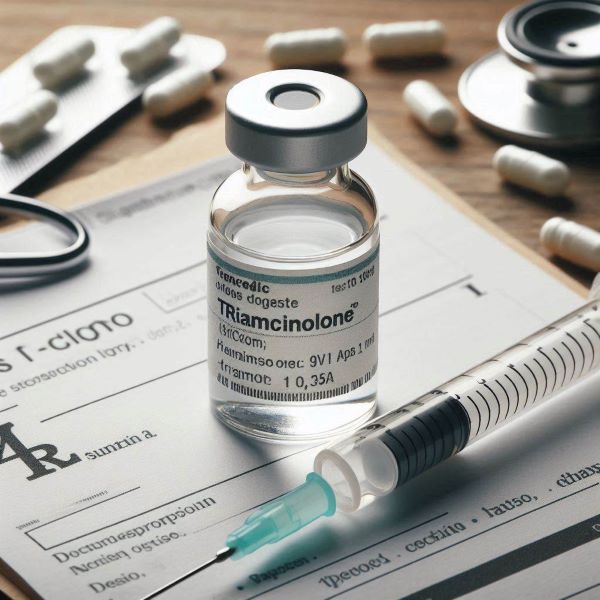Triamcinolone is a potent corticosteroid widely used in medicine to treat various inflammatory and autoimmune conditions. It is known for its anti-inflammatory and immunosuppressive properties, making it a versatile tool in the medical field. Understanding its uses, benefits, and potential side effects is crucial for patients and healthcare providers. This article provides a comprehensive overview of triamcinolone, explaining how it works, its uses, benefits, risks, side effects, availability, and legal status.
What is Corticosteroid Triamcinolone?
Triamcinolone is a synthetic corticosteroid that mimics the effects of hormones produced by the adrenal glands. It is used to reduce inflammation and suppress the immune system. Triamcinolone is available in various forms, including oral tablets, injectable solutions, topical creams, and inhalers, making it highly adaptable for different medical conditions. (Source)
Also, read: Quickly Know All About Corticosteroid Betamethasone: Uses, Benefits, Side-Effects
How Does It Work?
Triamcinolone works by binding to glucocorticoid receptors in the body, which influences the expression of certain genes involved in the inflammatory response. This action leads to a reduction in the production of pro-inflammatory cytokines and other mediators, effectively decreasing inflammation and immune activity. (Source)
Mechanism of Action
- Anti-Inflammatory Effects: Triamcinolone inhibits the release of substances in the body that cause inflammation.
- Immunosuppressant Effects: It suppresses the activity of the immune system, which can be beneficial in treating autoimmune diseases.
- Metabolic Effects: Triamcinolone affects carbohydrate, protein, and fat metabolism, influencing energy production and storage. (Source)
What are Its Uses?
Medical Uses
Triamcinolone is used to treat a wide range of conditions, including:
- Dermatological Conditions: Psoriasis, eczema, and dermatitis.
- Allergic Reactions: Severe allergic reactions and asthma.
- Rheumatologic Conditions: Rheumatoid arthritis, lupus, and other inflammatory joint diseases.
- Endocrine Disorders: Adrenal insufficiency and congenital adrenal hyperplasia.
- Neurological Conditions: Reducing swelling and inflammation in brain tumors or spinal cord injuries.
- Ophthalmologic Conditions: Uveitis and other inflammatory eye diseases.
- Pulmonary Conditions: Chronic obstructive pulmonary disease (COPD) and severe asthma. (Source)
Non-Medical Uses
Triamcinolone is sometimes used off-label for various purposes, though these uses should be approached with caution and under medical supervision:
- Enhancing Athletic Performance: Some athletes use corticosteroids to reduce inflammation and improve recovery times.
- Weight Gain: In cases of severe weight loss due to chronic illness, triamcinolone can help stimulate appetite. (Source)
Benefits
The benefits of triamcinolone include:
- Effective Anti-Inflammatory: Provides significant relief from inflammation-related symptoms.
- Immunosuppressive Properties: Helps manage autoimmune diseases and prevent organ transplant rejection.
- Symptom Relief: Quickly reduces symptoms of severe allergic reactions and asthma.
- Versatility: Available in multiple forms, allowing for tailored treatment approaches.
What are the Risks?
While triamcinolone is highly effective, it comes with several risks and potential side effects.
Side Effects
- Short-Term Use:
- Increased appetite
- Weight gain
- Insomnia
- Mood changes
- Elevated blood sugar levels
- Long-Term Use:
- Osteoporosis
- Muscle weakness
- Increased risk of infections
- Thinning skin
- Easy bruising
- Cataracts and glaucoma
- Suppressed adrenal gland hormone production
- Delayed wound healing
- Serious Side Effects:
- Severe allergic reactions
- Swelling and weight gain around the midsection, face, and back of the neck
- Changes in menstrual periods
Also, watch web stories: Seven types of Pranayama will keep you Healthy and Fit Always
Where is it Available and Where is it Banned?
Availability
Triamcinolone is available by prescription in most countries and comes in various forms, including tablets, injections, topical preparations, and inhalers. It is widely used in hospitals and clinics due to its effectiveness and versatility.
Legal Status
The legal status of triamcinolone varies by country, but it is generally regulated as a prescription-only medication:
- United States: Available by prescription only.
- Canada: Prescription-only medication.
- United Kingdom: Prescription-only.
- Australia: Classified as a prescription medication.
- International: Most countries regulate triamcinolone as a prescription drug due to its potent effects and potential for misuse.
FAQs
1. Can triamcinolone be used long-term? Long-term use of it can lead to significant side effects and should only be done under strict medical supervision.
2. Is triamcinolone safe during pregnancy? It should be used during pregnancy only if the potential benefits outweigh the risks. It is essential to consult a healthcare provider.
3. Can triamcinolone be used for skin conditions? Yes, it is commonly used to treat various dermatological conditions such as eczema and psoriasis.
4. How is triamcinolone administered? It can be administered orally, by injection, topically, or via inhalation, depending on the condition being treated.
5. Are there alternatives to triamcinolone? Other corticosteroids, such as prednisone or dexamethasone, may be used as alternatives, depending on the specific medical condition and patient needs.





